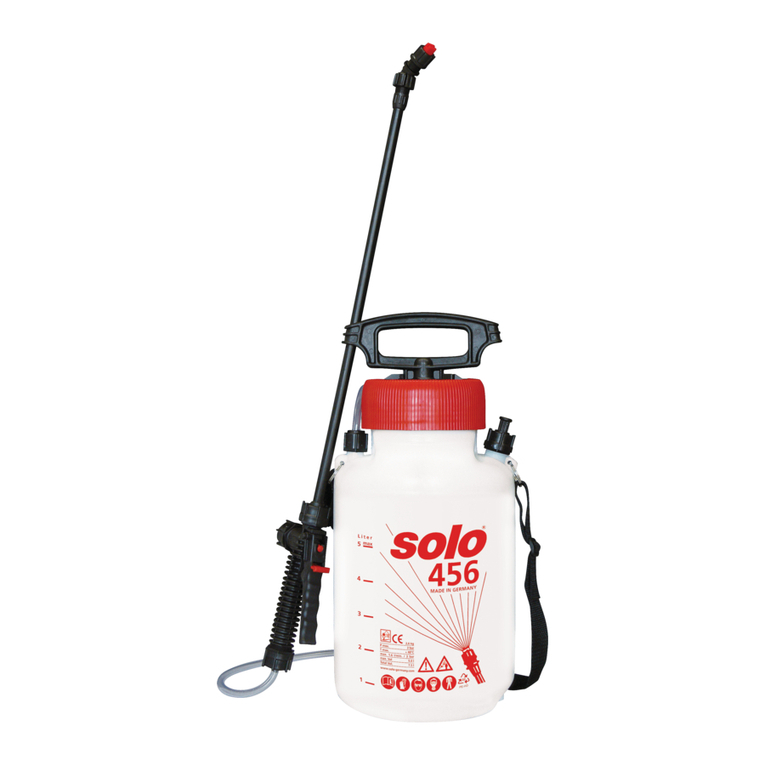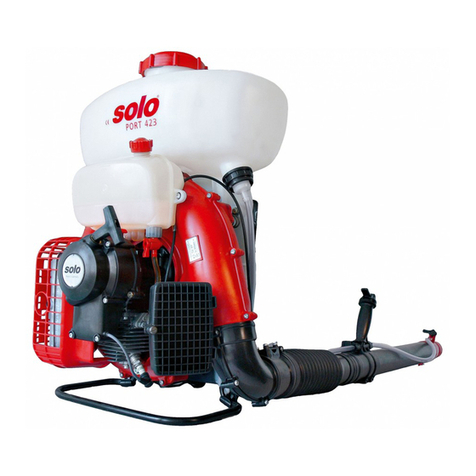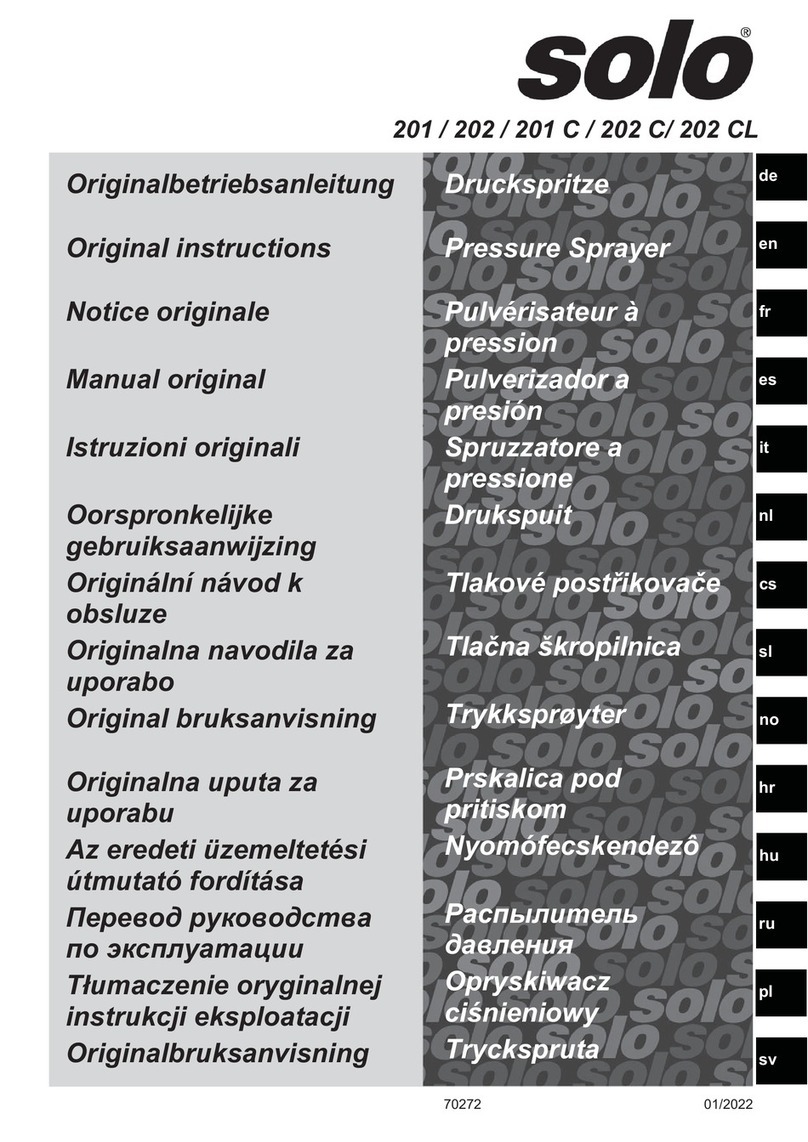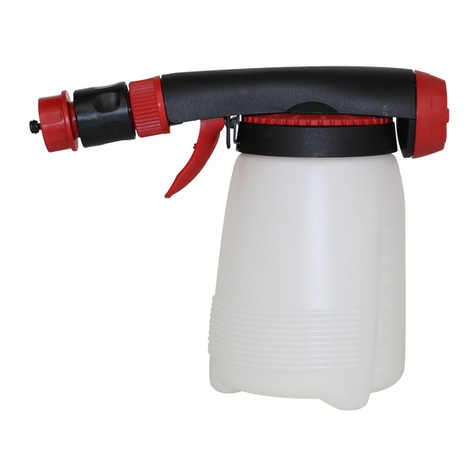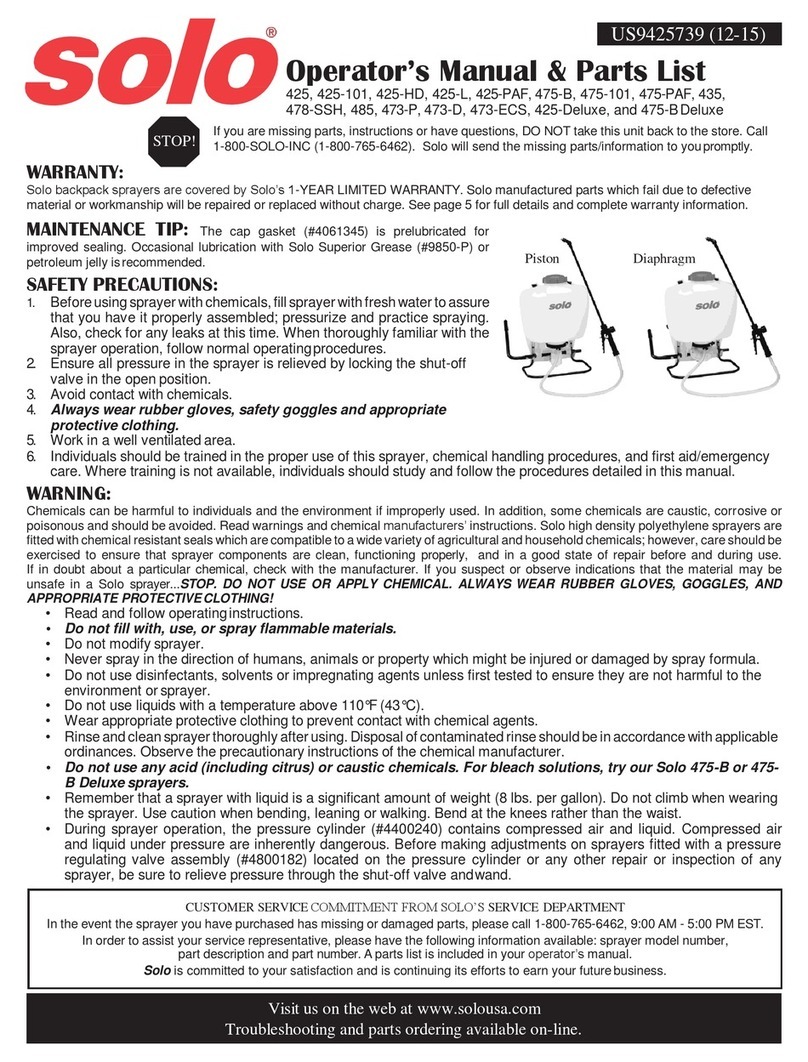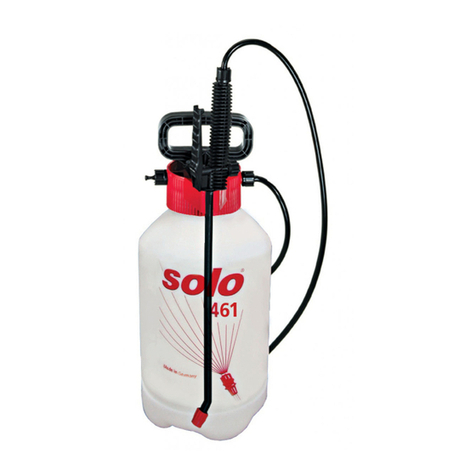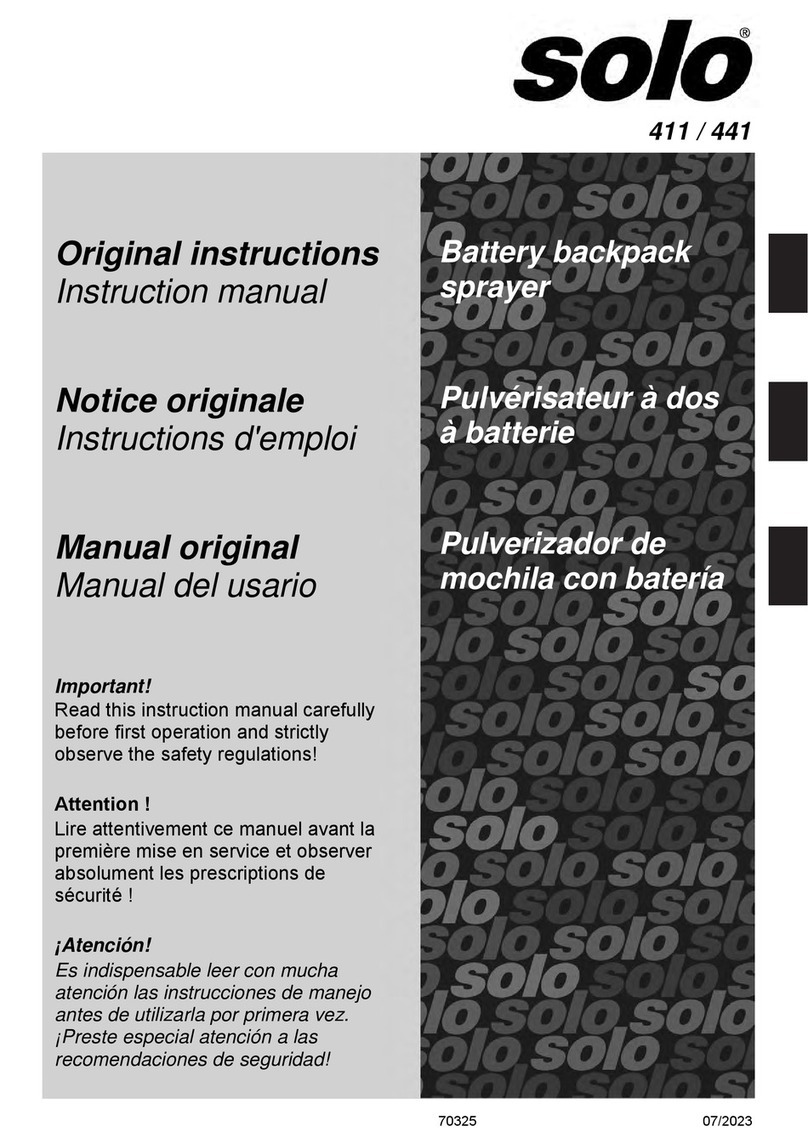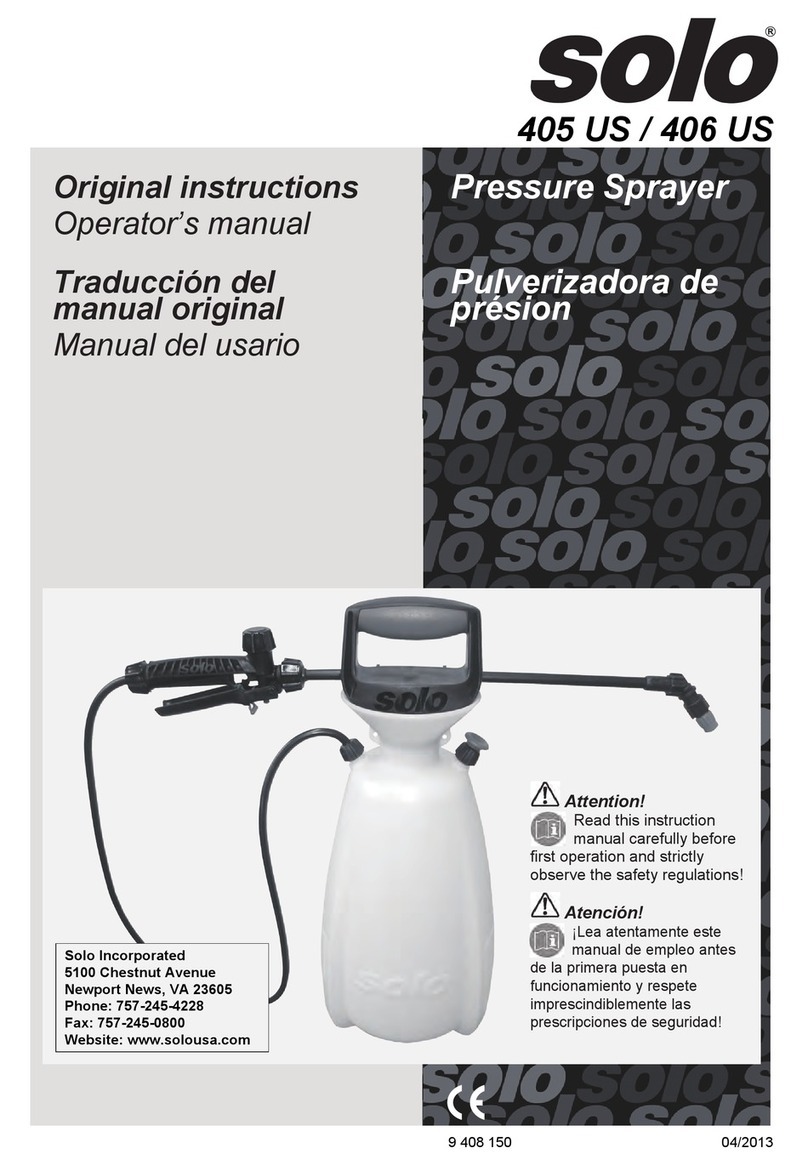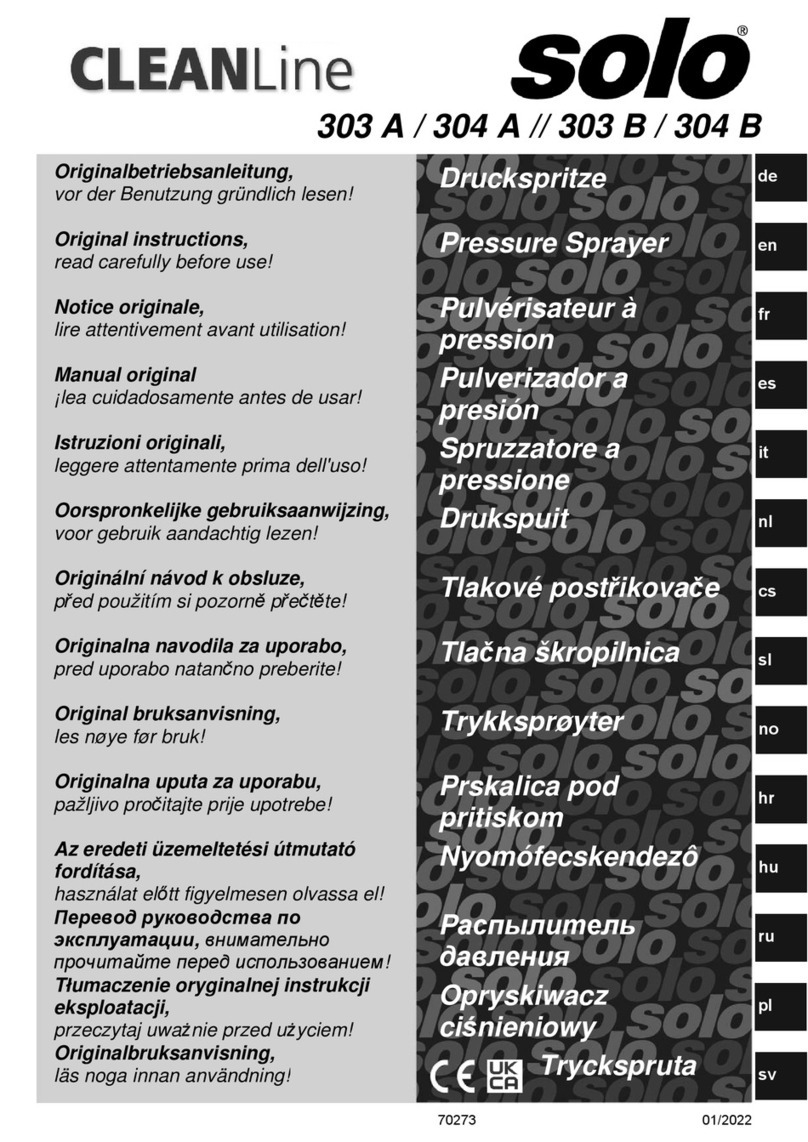
DEUTSCH 6
1.3 Sicherer Umgang mit Spritzmitteln
Die Hinweise der Mittelhersteller sind unbedingt
zu beachten.
Die Kontamination der Umwelt, des
Wasserleitungsnetzes und/oder der Kanalisation
mit Spritzmittel und Reiniger ist auszuschließen!
Durch geeignete Vorgehensweisen und
Auffangbehälter ist sicherzustellen, dass beim
Mischen, Einfüllen, Anwenden, Entleeren,
Reinigen, Warten und Transport keine
Kontamination stattfindet. Verschüttetes
Spritzmittel sofort abwischen
Spritzmittel und Reiniger dürfen auf keinen Fall –
auch nicht durch Rücksog beim Befüllen – in das
Wasserleitungsnetz gelangen, der öffentlichen
Kanalisation zugeführt, auf Ödlandflächen
ausgebracht, natürlichen Gewässern zugeführt
oder dem Hausmüll beigegeben werden.
Spritzmittel und Reiniger bzw. die Reste von
Spritzmitteln und Reinigern immer in einem
geeigneten Behälter auffangen und bei den
Sammelstellen für Haushaltschemikalien
abgeben. Auskünfte zu Sammelstellen für
Haushaltschemikalien sind bei den kommunalen
Verwaltungsstellen zu erfragen.
Vermeiden Sie direkten Kontakt mit
Spritzmitteln. Bei Haut- oder Augenkontakt mit
gesundheitsgefährdenden Spritzmitteln
betroffene Körperteile sofort mit reichlich
sauberem Wasser ab- bzw. ausspülen, mit
Spritzmittel durchnässte Kleidung sofort
wechseln und umgehend einen Arzt aufsuchen.
Erlauben sie niemals Kindern oder Personen,
die mit dem Umgang mit Spritzmitteln nicht
vertraut sind, das Arbeiten mit Spritzmitteln.
Niemals unterschiedliche Spritzmittel in den
Spritzmitteltank einfüllen. Bei Wechsel des
Spritzmittels müssen der Spritzmitteltank und
alle spritzmittelführenden Teile gereinigt werden.
Die Druckspritze nach dem Reinigen des
Spritzmitteltanks und vor dem Einfüllen des
neuen Spritzmittels, erst mit klarem Wasser
betreiben, um Rückstände aus der Pumpe und
den Schläuchen auszuspülen. Eventuelle
chemische Reaktionen werden dadurch
vermieden.
Beim Arbeitsende das Gerät gemäß Kap. 5.3 zur
Lagerung vorbereiten, verbleibende Reste von
Spritzmittel können zur Beschädigung des
Gerätes führen. Besonderes Augenmerk gilt den
Verschleißteilen wie Düsen, Filter und
Dichtungen. Arbeitskleidung ablegen und
regelmäßig waschen, Gesicht und Hände
gründlich mit Wasser und Seife reinigen.
1.4 Arbeitskleidung /
Persönliche Schutzausrüstung (PSA)
Zweckentsprechende, vorschriftsmäßige
Schutzkleidung, die alle Körperteile vor Kon-
takt mit Spritzmittel schützt, ist zu tragen –
Schutzhandschuhe, Gesichtsschutz (z. B.
Schutzbrille), Fußschutz, Körperschutz (z. B.
Gummischürze), ggf. Atemschutz.
Tragen Sie Schutzhandschuhe mit
rutschfester Grifffläche.
Verwenden Sie einen Gesichtsschutz.
Bei der Verwendung von gefährlichem
Spritzmittel Atemschutzmaske verwenden.
Mit Spritzmittel durchnässte Arbeitskleidung
sofort wechseln.
Arbeitskleidung regelmäßig waschen.
1.5 Beim Gerätetransport
Um Beschädigungen zu vermeiden und unter
Berücksichtigung der möglichen Gefahren im
Straßenverkehr ist das Gerät beim Transport in
Fahrzeugen gegen Umkippen und gegen
Herumfliegen durch Festschnallen zu sichern.
Das Auslaufen von Spritzmittel ist
auszuschließen. Vor dem Transport das Gerät
ordnungsgemäß entleeren.
1.6 Vor und bei der Arbeit
Überprüfen Sie vor jedem Arbeitsbeginn das
komplette Gerät gemäß Kap. 2.2 auf betriebs-
sicheren Zustand. Das Gerät darf nur im
betriebssicheren Zustand verwendet werden.
Achten Sie vor dem Pumpen darauf, dass das
Handventil (5) geschlossen ist. Richten Sie das
Spritzrohr (6) auf einen freien Bereich.
1.7 Bei Wartung, Reparatur und
Aufbewahrung
Führen Sie nur solche Wartungs- und
Reparaturarbeiten selbst aus, die in dieser
Gebrauchsanweisung beschrieben sind. Alle
anderen Arbeiten sind von einer autorisierten
Fachwerkstatt auszuführen.
Das Gerät darf nicht in der Nähe von
offenem Feuer gewartet, repariert oder
aufbewahrt werden.
Bei allen Reparaturen dürfen nur SOLO-
Originalersatzteile verwendet werden.
Am Gerät dürfen keine Änderungen
vorgenommen werden, da hierdurch die
Sicherheit beeinträchtigt werden kann und
Unfall- und Verletzungsgefahr besteht!






